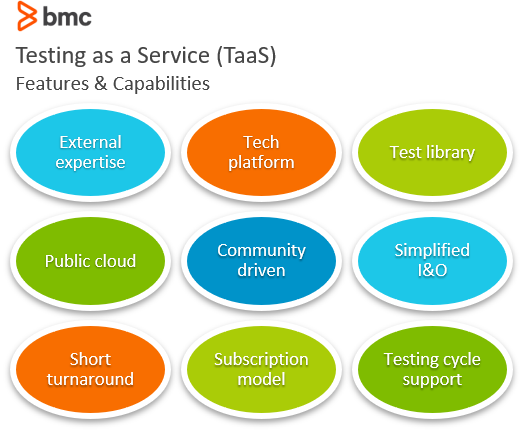Software testing is becoming ever more important, especially in DevOps organizations. That’s due to many reasons:
- Our software quality expectations are rising continuously and rapidly.
- Business organizations are pushing to release high quality products through fast release cycles.
- Highly regulated industries are enforcing stringent requirements on software quality.
- The chain of IT operations is becoming as complex as the technology itself—limited resources, inadequate governance, and manual processes are pushing the demands for on-demand, self-service, and automated IT capabilities.
These drivers extend to the realm of software testing, an integral part of the Software Development Lifecycle (SDLC) process, through mechanisms of continuous testing and automated testing. In this regard, the industry is embracing IT as a utility, where IT operations and testing processes are automated, streamlined, and integrated into modern SDLC frameworks.

The concept of Software Testing as a Service (TaaS) fits nicely in this domain. Testing as a service is rising in popularity among IT-driven organizations that lack the technology, human, and financial resources necessary for rapid, continuous, and automated testing.
In this article, we will discuss what Testing as a Service means and the capabilities suitable for your IT organization.
What is Testing as a Service (TaaS)?
Testing as a Service is the outsourcing of activities and operations associated with software testing activities. Like its cloud-based, as-a-service predecessors, the TaaS capabilities are accessed across a Web interface and include several self-service capabilities such as:
- Test cases
- Security controls
- Infrastructure management activities
TaaS can take various shapes and forms. A complete testing cycle may include end-to-end support and technology capabilities used in planning and conducting software testing. In this mode, you engage a third-party vendor for two main reasons:
- To guide the testing process
- To perform the necessary testing functionality
In other cases, a TaaS service may be a technology platform that combines the software and hardware components to deliver specific testing capabilities as a service.
The service can be grouped into functional and non-functional aspects of software testing.
Functional testing in TaaS
Functional testing finds the answer to the simple question:
Does the software behave as expected against a given set of test cases?
Functional testing involves the technology process itself, such as:
- Writing the test scripts
- Configuring the environment
- Implementing and executing the test cases
Non-functional testing in TaaS
Non-functional testing deals with the related aspects of software quality. These include usability, security and performance, among others. Non-functional testing evaluates the behavior of software components in the greater scheme of things:
- Application integrations with other components of the infrastructure
- Impact on user experience
- Defense against cyberattacks

Capabilities & features of TaaS
Both functional and non-functional testing is achieved with the following features and capabilities of any good Testing as a Service solution:
- External expertise. Finding the right set of technology solutions, designing test cases, and managing infrastructure operations to meet business demands.
- Technology platform. A self-service portal lets users test their builds against custom and predefined test cases.
- Test library. A large set of test cases with configurable parameters that can be used as templates and customized for various user scenarios.
- Public cloud. A shared pool of data center resources that can be used to execute resource-intensive cases, automatically and in parallel.
- Community driven. The testing library continues to grow as the vendor and the community of users add new test cases, improving the overall utility of the TaaS platform.
- Simplified infrastructure & operations. The vendor is responsible for managing the underlying technology; users take advantage of the self-serviced platform capabilities of the service.
- Short turnaround. Test results are readily available, depending on IT workload and the resources allocated. Multiple tests can be conducted continuously and in parallel, which is particularly suitable for the DevOps SDLC pipeline.
- Subscription model. The technology resources are always available on demand. Instead of investing in dedicated technologies that may not suffice to meet scalable workload requirements, organizations consume the resources as needed on a subscription basis.
- Testing cycle support. Vendors offer end-to-end support that covers planning, implementing, and evaluating software tests.
Slow pace of testing innovation
Although software quality assurance is integral to the process of building innovative new technologies, the testing process itself isn’t keeping pace with release cycles. According to a recent research survey of tech companies in the North America region by Capgemini, 74% of the respondents suggested that QA was essential for business growth and end-user satisfaction.
However, the current testing practices still lag behind in presenting the desired outcomes. According to the survey, only 29% of the respondents suggested that their testing efforts produce the desired outcomes. The void is primarily associated with the lack of technology resources and expertise available in-house:
- 47% attributed the difficulties to finding the right tools for testing automation.
- 41% said they didn’t have a good testing approach.
- 37% reported a lack of expertise.
With Testing as a Service solutions and automated testing in the cloud, this gap can be filled to validate software quality at the fast pace of DevOps and Agile release cycles.
Related reading
- BMC DevOps Blog
- DevOps Guide
- Shift Left Testing: What, Why & How To Shift Left
- Testing Frameworks: Unit Tests, Functional Tests, TDD & BDD Explained
- Deploying vs Releasing Software: What’s The Difference?
- SaaS in 2020: Growth Trends & Statistics
These postings are my own and do not necessarily represent BMC's position, strategies, or opinion.
See an error or have a suggestion? Please let us know by emailing blogs@bmc.com.




